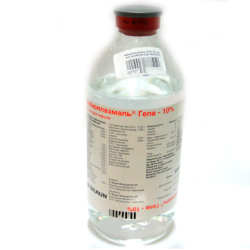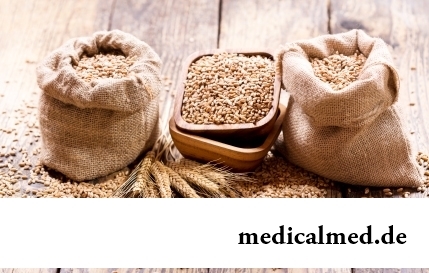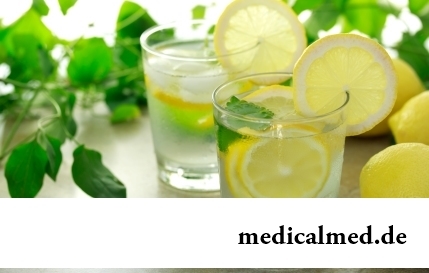





Gep's aminoplasmal
Application instruction:
 Gep's aminoplasmal – the drug for parenteral food at a liver failure normalizing Fischer's coefficient, level of aromatic amino acids and amino acids with a branched chain reducing expressiveness of symptoms of hepatic encephalopathy, reducing concentration of ammonia in blood.
Gep's aminoplasmal – the drug for parenteral food at a liver failure normalizing Fischer's coefficient, level of aromatic amino acids and amino acids with a branched chain reducing expressiveness of symptoms of hepatic encephalopathy, reducing concentration of ammonia in blood.
Form of release and structure
Dosage form of drug – solution for infusions of 10%: transparent, colourless or pale yellow liquid (on 500 ml in bottles of hydrolytic glass 2 classes corked brick color by a rubber bung, brick-red color an aluminum cap and gray color a plastic cap; for hospitals – on 10 bottles in a box cardboard).
1 ml of solution contain active ingredients:
- Alanine – 8,3 mg;
- Arginine – 8,8 mg;
- Asparagine monohydrate – 0,55 mg (0,48 mg of asparagine are equivalent);
- Aspartic acid – 2,5 mg;
- Atsetiltirozin – 0,86 mg (0,7 mg of tyrosine are equivalent);
- Acetylcysteinum – 0,8 mg (0,59 mg of cysteine are equivalent);
- Valine – 10,6 mg;
- Histidine – 4,7 mg;
- Glycine – 6,3 mg;
- Glutaminic acid – 5,7 mg;
- Isoleucine – 8,8 mg;
- Leucine – 13,6 mg;
- Lysine monoacetate – 10,6 mg (7,15 mg of a lysine are equivalent);
- Methionine – 1200 mg;
- Ornithine a hydrochloride – 1,66 mg (1,3 mg of ornithine are equivalent);
- Proline – 7,1 mg;
- Serine – 3,7 mg;
- Threonine – 4600 mg;
- Tryptophane – 1500 mg;
- Phenylalanine – 1600 mg.
Auxiliary components: sodium hydroxide or Acidum hydrochloricum (from 0 to 2,0 mmol), dinatrium of an edetat a dihydrate, water for injections.
Concentration of electrolytes in solution (mmol/l):
- Acetates – 51;
- Chlorides – 10.
Physical and chemical characteristics:
- pH – from 5,5 to 6,5;
- Caloric content – 1675 kJ/l (400 kcal/l);
- The general nitrogen – 15,3 g/l;
- Content of amino acids – 100 g/l;
- Theoretical osmolarity – 875 ¼Äß¼/l.
Indications to use
Gep's aminoplasmal is used for parenteral food in case of disturbance of amino-acid balance which arises at chronic or acute diseases of a liver, and also for the purpose of the prevention and therapy of hepatic encephalopathy.
Considering specifics of amino-acid structure, solution is required to be applied only according to the listed indications. Use of drug in other cases can lead to disturbances of amino-acid exchange.
Contraindications
- The expressed acidosis;
- Overhydratation;
- The expressed hypopotassemia;
- The expressed hyponatremia;
- Disturbances of blood circulation of heavy degree (shock);
- Disturbances of exchange of amino acids of an extrahepatic etiology;
- Fluid lungs;
- Pregnancy and period of breastfeeding;
- Children's age up to 2 years;
- Hypersensitivity to any of components.
With care solution is applied at patients with the increased level of osmolarity of plasma.
Route of administration and dosage
Solution Aminoplazmal Gepa is intended for intravenous administration with use of the central venous catheter.
It is required to follow the following rules of use of drug:
- The solution dose which is contained in 1 bottle is counted on single use;
- Any unused volume of drug is not subject to further storage and has to be utilized;
- Drug is not suitable for use if on a bottle explicit traces of damages are visible, tightness is broken, solution is not transparent.
If there are no other instructions, taking into account individual needs of patients, it is recommended to use solution in the following doses:
- Adults, standard dose: on body weight kg a day – 7-10 ml that corresponds to 700-1000 mg of amino acids;
- Adults, maximum dose: on body weight kg a day – 15 ml that corresponds to 1500 mg of amino acids;
- Children since 2 years, a standard dose: on body weight kg a day – 7-10 ml that corresponds to 700-1000 mg of amino acids.
In case of purpose of solution Aminoplazmal Gepa to children is especially carefully considered age of the child, his nutritsionny status and the main diagnosis.
In need of transition to full parenteral food it is also necessary to enter carbohydrates, microelements, vitamins and irreplaceable fatty acids.
Patients with hepatic encephalopathy at the beginning of therapy are recommended to enter solution with a high speed, before clinically significant improvement.
The recommended infusion speed for the patient weighing 70 kg:
- First 2 hours: 50 caps/min. that there correspond ~ 150 ml/h or 2 ml/kg/h;
- 3-y-4-y hour: 25 caps/min. that there correspond ~ 75 ml/h or 1 ml/kg/h;
- From the 5th o'clock: 15 caps/min. that there correspond ~ 45 ml/h or 0,6 ml/kg/h;
- Parenteral food, maintenance therapy: 15-25 caps/min. that there correspond ~ 45-75 ml/h or 0,6-1 ml/kg/h.
Use drug for parenteral food up to elimination of threat of development of hepatic encephalopathy.
Side effects
In case of strict observance of rate of administering of solution, a dosage of drug and the recommended precautionary measures when performing infusion, side effects are absent, but it is impossible to exclude a possibility of development of reactions of hypersensitivity.
At overdose or exceeding of the recommended speed of infusion can be observed: nausea, vomiting, fever, increase in excretion of amino acids kidneys. In that case administration of drug is required to be stopped and resumed immediately after a while, having reduced infusion speed.
Special instructions
It is forbidden to enter solution Aminoplazmal Gepa into peripheral veins.
At a renal failure the dose of amino acids korrigirutsya depending on the level of creatinine and urea in serum.
Use for treatment of hepatic encephalopathy of solutions of amino acids does not exclude other established therapeutic measures.
Complex use of other nutrients along with infusion of amino-acid structure is shown: introduction of adequate amount of carbohydrates, use of electrolytes according to requirements, etc.
In the course of therapy control of concentration of glucose in blood, water and electrolytic balance, osmolarity of plasma, acid-base balance and function of a liver is necessary. The way of control and frequency of its carrying out depend on weight of a condition of the patient and sharpness of course of a disease.
Duration of infusion of solution from one bottle should not be more than 24 hours.
Medicinal interaction
At the moment there are no data on medicinal interaction of a complex of amino acids with other substances / drugs.
Because of danger of physical and chemical incompatibility and bacterial contamination Aminoplazmal Gepa is not recommended to add to solution medicines, it is preferable to include them in standard solutions of electrolytes or carbohydrates. It does not exclude a possibility of mixing of other solutions for parenteral food with Aminoplazmal Gepa after conducting check on their compatibility.
Terms and storage conditions
To store in the dark place, at a temperature not above 25 °C. To protect from children. Not to freeze!
Period of validity – 3 years.
Blood of the person "runs" on vessels under huge pressure and at disturbance of their integrity is capable to shoot of distance to 10 meters.

No, probably, the person who would not have cold. Cold, cough, a headache – these symptoms are known to everyone. Peak to Prost...
Section: Articles about health
Since the moment when the child becomes a school student, his sight begins to be exposed to the strengthened loadings which are supplemented with viewing of animated films and long computer games. During this period of life of the child development not completely created bodies to a zra...
Section: Articles about health
Good appetite was always considered as a sign of good health. The correct operation of the mechanism which is responsible for the need for nutrients and receiving pleasure from process of its satisfaction demonstrates that the organism functions without special deviations. On the other hand, appetite of the person is not a constant. It depends on the culture of food, flavoring addictions imparted since the childhood which can change during life, weather, mood and many д more than once...
Section: Articles about health
Insufficiently strongly expressed sexual desire or lack of satisfaction from sexual contacts can test time from in...
Section: Articles about health
What will only not be thought up by persons interested to have a beautiful figure. Here the last innovation – for weight loss needs to be eaten greasy food. Let's understand whether there is at a fatty diet common sense....
Section: Slideshow
Scientists always aimed to offer fundamental explanations for medical problems. Their theories formed the basis of modern methods of treatment of the hardest pathologies and helped to save a set of lives. However stories are known also such theoretical constructions, following to which brought to mankind of a trouble and torture, ruined destinies and health of many people....
Section: Articles about health
Contrary to popular belief, the multiple sclerosis (MS) is not connected neither with sclerous changes of walls of vessels, nor about age...
Section: Articles about health
On the head of the person about one million hair follicles, or as they are called still, hair bulbs are located. At the time of the birth most of them is in the "sleeping" state, but within several weeks follicles become more active, and from them begin р...
Section: Articles about health
"Epilepsy" doctors made the diagnosis in antique times. Displays of an illness and pattern of its development are very well studied. However for nonspecialists this disease remains to not less mysterious, than in the ancient time. Many delusions are connected with epilepsy, and it sometimes very unpleasantly affects quality of life of patients and their relatives. In this article we will try to dispel the most known of similar myths....
Section: Articles about health
Tea is loved and use almost everything. This drink has tonic properties, contains the tannins capable podavlit...
Section: Articles about health
Several decades ago the basil (the district khan, реан, Reagan) was considered as a part of the Caucasian or east cuisine, but today it strongly took the place on tables of Russians. Greens of this plant possess a strong, pleasant smell and specific fresh taste, because of to...
Section: Articles about health
Childbirth is the most important event in life of each woman. We are women we give birth to the new little man on this light. Now the tendency to that was outlined, as men want to participate in labor too. But there is a question and whether it is worth allowing the husbands on childbirth?...
Section: Articles about health
Feeding by a breast - the integral part of ideal motherhood allowing to come into contact with the kid and to create since early years...
Section: Articles about health
The concept "gluten" (differently, a gluten) combines group of the proteins which are a part of rye, barley and wheat. For most of people the use of the food stuffs containing a gluten not only is safe, but also it is very useful. Nevertheless, there is a number the myth...
Section: Articles about health
Reactive pancreatitis - the disease which is characterized by inflammatory process in a pancreas which arises most often because of excess activity of digestive enzymes. It − the emergency state which treatment has to take place in surgical department under control of doctors. The acute inflammation of gland can become the reason of its transition to a chronic form, and also development is purulent - necrotic pancreatitis which the extensive necrosis of fabrics can follow. Zabolev...
Section: Articles about health
Obesity is called by a disease of 21 centuries, for the last 100 years by the number of the people suffering from excess body weight, considerably increased...
Section: Articles about health
Life of the modern woman is very difficult. Opportunities to realize itself are wide: it not only education and career, but also the most various hobbies from sport before needlework. It is not less important to build private life, paying an attention maximum to children, the husband, parents, e...
Section: Articles about health
Phobia – the persuasive fear of a certain contents shown in a specific situation against the will of the person. Concepts of a phobia and fear are similar, however if the fear is natural protective function of mentality, then the phobia is its deviation. So the person can feel the unaccountable, baseless fear accompanied with neurotic symptoms (perspiration, a shiver, a fever) before any ordinary phenomenon – for example, a trip by the subway or a simple dog....
Section: Articles about health
On health of the person physicians know about salutary action of animals long ago. About 7 thousand years ago great Hippocrates рекоменд...
Section: Articles about health
Epilepsy is one of widespread neurologic diseases. Parents, whose children suffer from this illness, should face rumors and delusions, many of which remained since the Middle Ages....
Section: Articles about health
More than a half of the married couples which faced prostatitis – leave. The new broadcast "Female View of Prostatitis" will help to learn – whether you have or your relatives problems....
Section: Articles about health
Eyes – one of the most vulnerable areas on a face therefore age changes concern them first of all. Whether it is possible to keep a pier...
Section: Articles about health
Nightmares belong to the most unpleasant frustration. Statistically, they happen at 4% of adults, and almost at 70% of children and teenagers. During a nightmare of people dreams himself in extremely difficult, life-threatening situation. It wakens suddenly, in...
Section: Articles about health
Water with a lemon - idle time in preparation drink which supporters of a healthy lifestyle already managed to appreciate. Used in a warm look and on an empty stomach, it is one of the most useful prophylactics allowing to prevent tens of diseases and just to raise an organism tone. Especially effectively to use warm water with lemon juice after a serious illness, during a season of the colds, and also to children, old men and pregnant women which do not have contraindications...
Section: Articles about health
Practically each person is familiar with the annoying, pulling, unscrewing pains caused by overcooling of muscles of a back. In некото...
Section: Articles about health
Hemorrhoids – extremely widespread disease. Periodically arising inflammations and bleeding of hemorrhoidal nodes cause serious discomfort to nearly fifteen percent of adults. Meanwhile, having a clear idea of the aggravation reasons...
Section: Articles about health
Condition of lips (their morbidity, outward) – one of indicators of health of the person. The peeling, dryness, pallor, and also cracks in corners of a mouth can be not only the cosmetic shortcoming which arose owing to physical damages and weather conditions but also the satellite of some diseases and disturbances in an organism needing treatment. Let's consider 10 possible reasons of emergence of angular cracks (perleches) in corners of a mouth and ways of their elimination....
Section: Articles about health
